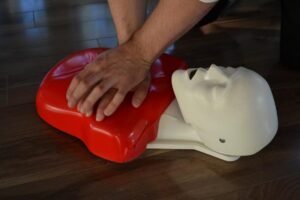For many, hearing the term drowning evokes a number of water-related events such as screaming passengers from a sinking ship, a boat being swept by a strong storm or simply unable to swim in a public swimming pool.
It is vital to bear in mind that drowning can occur even at home. Drowning is considered uncommon but it becomes a threat when children are splashing in a paddling pool or sitting in a bath tub. Always remember not to leave a young child unattended since even an inch of water can cover the nose and mouth in case they fall forwards.
What you can do
- Lift the child out of the water and transport with the head at a lower position than the chest to minimize the risk for water inhalation.
- Any wet clothing must be removed and wrap the child with a dry blanket or towel
- If unconscious, open the airway and check the breathing. If breathing, place the child in the recovery position.
What to do for an unconscious child
For infants (birth to 1 year old)
- Open the airway by slowly tilting back the head and lift the chin
Position your hand over the middle of the chest and lean over. Perform 30 chest compressions by compressing down about a third of the depth of the chest. .
- Deliver rescue breaths by placing your mouth over the mouth and nose and steadily blow for about a second until the chest rises. Perform this at least 5 times.
- Position 2 fingers at the middle of the chest and perform 30 chest compressions by compressing about a third deep.
- Deliver 2 rescue breaths and then followed by 30 chest compressions. Continue this cycle for about a minute.
- Call for emergency assistance and repeat the cycle of rescue breathing and chest compressions until the medical team arrives or until the child starts to breathe again.
For a child (1 year and up)
- Open the airway by slowly tilting back the head and lift the chin.
- Deliver rescue breaths by first pinching the nose and deliver rescue breaths by positioning the mouth over the mouth and blow until the chest rises. This must be repeated 5 times.
- Position your hand over the middle of the chest and lean over. Perform 30 chest compressions by compressing down about a third of the depth of the chest.
- Deliver 2 rescue breaths followed by 30 chest compressions. Follow this technique for one minute.
- Call for emergency assistance and follow the cycle of rescue breathing and compressions until help arrives or once the breathing of the child is restored.

